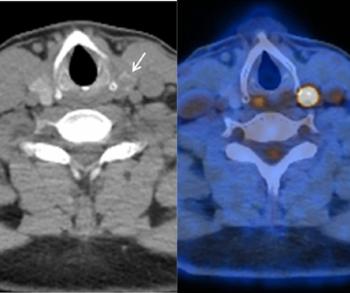
Radiotherapy dominates products cleared by FDA in April
Nearly a third of the 25 radiology-related applications passing FDA muster in April address radiation oncology. The rest were split among MRI, ultrasound, image management, and nuclear medicine. Standouts included two ultrasound systems, an x-ray
Nearly a third of the 25 radiology-related applications passing FDA muster in April address radiation oncology. The rest were split among MRI, ultrasound, image management, and nuclear medicine. Standouts included two ultrasound systems, an x-ray fluoroscope dedicated to urology, and an MRI upgrade.
Pentax Precision Instrument of Orangeburg, NY, gained 510(k) clearance April 17 for its Fiber Ultrasound Gastroscope, an endoscope that combines optical and ultrasonographic visualization. The system, designated FG-36UX, is designed for use in the upper gastrointestinal tract: esophagus, stomach, duodenum, small bowel, and underlying areas. One point of the bifurcated umbilicus is connected to an ultrasound scanner, and the other to a light source with air/water and suction controls. The branch dedicated to optical imaging contains fiber bundles for illuminating the body cavity and then optically visualizing the anatomy. A convex linear transducer provides ultrasonic data. The instrument is also equipped with two biopsy forceps. The control body allows up and down and left and right angulation, accessory elevator control, and delivery of air and water, as well as the modulation of suction.
Type 2102 from B-K Medical of Denmark is a shared services ultrasound product designed for applications in urology, cardiology, and ob/gyn. The system, which offers B-mode, M-mode, color Doppler, pulsed-wave Doppler, and harmonic imaging, cleared the FDA April 3. It can be used diagnostically and to guide biopsy. Transducers feature linear and convex arrays, as well as a mechanical sector.
The FDA granted permission April 12 for Siemens Medical Solutions to market its U04 urology system. The fluoroscopic x-ray system is designed for urologic, gastroenterologic, and gynecologic treatment, planning, and diagnostic procedures. The product features an undertable image intensifier and can be operated using either tableside handheld controls or from a control desk. System and stand are based on components built into Siemens’ Iconos R200 product. The primary distinction between the new device and preceding ones is a digital imaging system with CCD camera built into the U04.
Fiesta 2-D and 3-D, developed by GE Medical Systems, are designed to enhance contrast and temporal resolution in MRI scans. The option, which was cleared April 11 by the FDA, uses balanced gradients to maintain phase coherence of transverse magnetization. The agency judged Fiesta to be substantially equivalent to the fast gradient-echo technique implemented in the Signa CV/i system, which is optimized for cardiovascular imaging. Intended for whole-body applications, Fiesta 2-D may be especially helpful in imaging dynamic structures, such as the heart. Fiesta 3-D may be particularly useful in imaging of the bile ducts and may also be suited for rapid acquisition of such static structures as joints and the cochlea, in which high spatial resolution is important.
Three of the oncology products cleared by the FDA were radionuclide products designed for implantation. One of these, GliaSite RTS (radiation therapy system), was evaluated in both in vitro and clinical testing by developer Proxima Therapeutics of Alpharetta, GA. In vitro tests demonstrated substantial equivalence to existing brachytherapy applicators. A multicenter phase II clinical study demonstrated safety and effectiveness in patients with resected intracranial tumors, according to the company. The product, which cleared the FDA April 25, is designed specifically for treating malignant brain tumors following tumor resection. It includes a catheter and accompanying tray, an iodine-125 radiation source called Iotrex, and an access tray. The catheter is a double-balloon applicator that positions the radiation source within a resected cavity. The access tray contains items needed for afterloading and retrieval of the radiation source.
Radiotherapy
- EchoSeed/iodine-125 seeds, Model 6733 (Amersham, cleared April 11). The brachytherapy seed, designed primarily as a treatment for prostate cancer, consists of a welded titanium capsule containing I-125 absorbed onto a silver wire. Six grooves are etched on the outer surface of each capsule to improve visualization with ultrasound in the hope that this will enhance guidance and placement of the seed, which measures less than 5 mm in length and 1 mm in diameter. EchoSeed can be engineered to exhibit a range of activities from 0.297 to 0.673 mCi with a half-life of 59.43 days. The seeds are packaged in a screw-cap glass vial housed in a lead container.
- TheraSeed palladium-103 implant, Model 200 (Theragenics, cleared April 26). Modeled after an earlier version of the company’s palladium-based seed, Model 200 contains two palladium-103-plated graphite pellets and a lead x-ray marker. The product is designed for localized and unresectable tumors exhibiting low to moderate radiosensitivity.
- Plato SRS Version 2 (Nucletron, cleared April 10). This set of software modules enhances Nucletron’s stereotactic radiosurgery planning system. The upgrade improves the correlation and display of images from different modalities, such as CT and MRI, while supporting the transfer of user-defined contours from images of one modality to another using image fusion.
- Multiple tray adapters (Arplay Medical, cleared April 18). Tray adapters adjust the radiation therapy unit to utilize beam blocks that help define the radiation field. They may also be used to incorporate treatment field accessories not initially provided with the radiation therapy unit.
- Lead blocks (Arplay Medical, cleared April 18). This product is used to shape the radiation beams from linear accelerators and from cobalt treatment machines.
- Couch for total body radiation (Arplay Medical, cleared April 2). The couch consists of a steel frame enclosed in aluminum sheeting with a wooden couch top. The top is raised and lowered on four screws by an electric motor.
- Dosimetry Check (Math Resolutions, cleared April 24). This software program is designed to test the dosimetry of radiation therapy treatment. Data are obtained in a simulated treatment completed without the patient present.
Ultrasound
- 8EC4 Endocavity Smart Probe (Teratech, cleared April 6). Intended for endorectal and endovaginal imaging, 8EC4 extends the imaging capability of the Teratech 2000 portable ultrasound imaging system. It operates at 5.0 MHz and generates between 48 and 101 frames per second.
- AT3C70 transducer (Sonora Medical Systems, cleared April 2). The curved-array transducer, capable of imaging at 3.5 MHz and Doppler at 3.0 MHz, is dedicated to fetal and abdominal applications.
MRI
- Model 455GE phased-array wrist coil (Medical Advances, cleared April 3). The specialty coil, designed and tested on a Signa 1.5-tesla MRI scanner, accommodates 95% of the general population from the distal end of the third metacarpal to 3 cm above the distal end of the radius/ulna.
- Proton spectroscopy package (Toshiba America Medical Systems, cleared April 5). Running on a separate workstation, the software allows analysis of proton spectroscopy data obtained using the Excelart MRT-150 Pianissimo. Spectroscopy is designed for head scans. Analyses include proton density, spin-lattice relaxation, spin-spin relaxation, and flow velocity.
- 3.0 T Signa VH/i body imaging coil (GE Medical Systems, cleared April 3). The coil expands the imaging capability of GE’s 3-tesla scanner, which has served since its 1996 introduction as a head scanner only (SCAN 4/25/01).
- Breast immobilization and biopsy device (MRI Devices, cleared April 9). Used in conjunction with an MRI scanner, the product permits guided breast biopsy and wire localization.
Image Management
- Mirage modification (Segami, cleared April 26). Release 5.0 enhances the Mirage system, which is designed for the acquisition, processing, review, and archiving of scintigraphy data. The new version is capable of processing and displaying acquired information in traditional formats, as well as in pseudo 3-D renderings and in various forms of animated sequences, showing kinetic attributes of the image organs.
- ThinkingNet (ThinkingNet Systems, cleared April 3). This PACS is capable of image management, communications, storage, archiving, and review. ThinkingNet is composed of several stand-alone software modules: MDStation for the review of images; NuPAX for image storage and archiving; NuLink as a connectivity gateway for the import and export of images; NuWEB as a Web-common gateway interface to allow image review on a Web browser; and StoreSCP, which features a storage-only capability.
- Mediface PACS (Mediface, cleared April 26). Product allows pictorial and text searching, search by key image, user-defined indices, window leveling of 16-bit gray-scale images, and brightness and contrast control over 24-bit color images.
- Drystar 4500, Model 4500 (Agfa Medical Imaging, cleared April 27). Free-standing device prints diagnostic images on transparent film without the need for wet chemical processing.
X-Ray
- Philips BV Libra (Philips Medical Systems North America, cleared April 2). The mobile C-arm is designed primarily for use in the operating room, but can also support diagnostic procedures, as well as provide guidance during interventions performed outside the OR. BV Libra is cleared for sale with a six- or nine-inch image intensifier. The product was first shown at the European Congress of Radiology (SCAN 3/14/01).
- Mammograph (Digitec Medical Service, cleared April 3). A clear vinyl sheet is placed over a breast image on the viewbox to reproduce markings and indicators found on the compression paddle. The overlay allows the operator to evaluate positioning and exposure techniques in film-based mammography and provides a 2-D coordinate system for referencing areas of interest within the image.
Nuclear Medicine
- Cedars-Sinai BPGS and MoCo (GE Medical Systems, cleared April 27). These two independent stand-alone software applications were developed by Cedars-Sinai Medical Center for automatic processing and analysis of nuclear medicine SPECT data. BPGS quantifies gated blood data obtained using technetium-labeled red blood cells. MoCo corrects patient motion encountered in SPECT studies.
- CAL/RAD Mark IV Dose Calibrator, Model 34-162 (Nuclear Associates, cleared April 26). An ionization chamber and control unit interact to verify the accuracy of radiation doses delivered to patients.
Newsletter
Stay at the forefront of radiology with the Diagnostic Imaging newsletter, delivering the latest news, clinical insights, and imaging advancements for today’s radiologists.




























